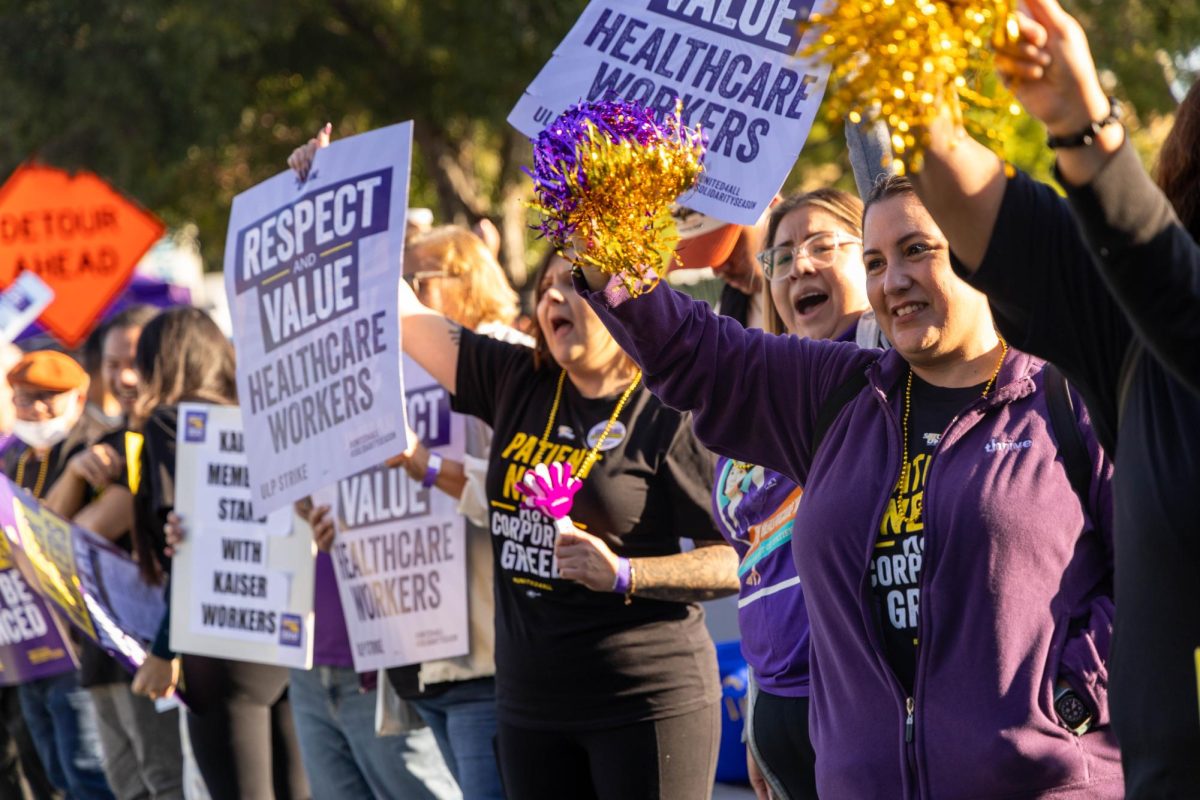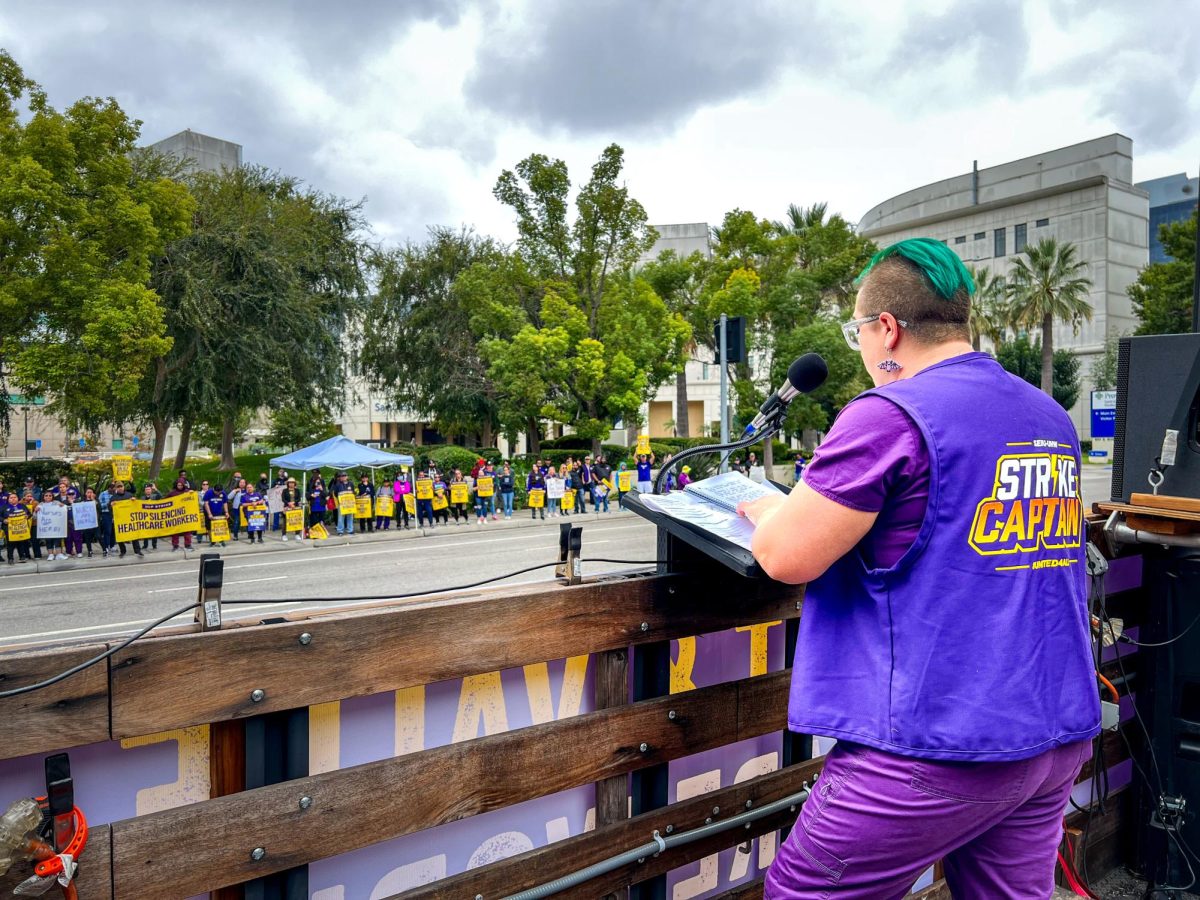For the purpose of maintaining his anonymity in this story, we will refer to a physician at Kaiser Permanente as Physician A.
America’s largest healthcare strike in history ended on Friday, Oct. 13 when Kaiser Permanente and its coalition of unions reached a tentative deal. Seventy-five thousand Kaiser Permanente workers nationwide hit strike lines from Oct. 5 to 7, arguing that Kaiser’s under-staffing crisis was hurting patients.
Workers represented by Kaiser’s coalition of unions include licensed vocational nurses, ER technicians and pharmacists and pharmacy technicians. The Oct. 13 contract — which affects 85 thousand Kaiser workers nationwide — promises a 21% salary increase in raises over the next four years to retain current workers. It also increases minimum wage for healthcare workers and invests in other initiatives to protect Kaiser’s workforce.
Service Employees International Union-United Healthcare Workers West (SEIU-UHW) represents over 100 thousand healthcare workers across California and played the largest role in October’s Kaiser strike. Though SEIU-UHW Press Secretary Renée Saldaña describes the strike as a last resort, she says it was crucial to the union’s goal of ensuring “affordable, accessible, high quality health care for all Californians.”
According to Saldaña, negotiations between union representatives and Kaiser executives over workers’ concerns began in April 2023. It was only after the strike began on Oct. 5, when executives saw the massive worker turnout, that Kaiser executives presented a new set of proposals that was more favorable to workers.
“This strike is what happens when workers stand together and all decide to withhold their labor in order to show how valuable it is,” Saldaña said. “Sometimes it takes employers to have a strike at their facility to really understand the gravity of the situation — how serious healthcare workers are about the short staffing crisis, about needing to make a living fair wage here in California and about them really being able to give the best patient care possible.”
Understaffing in healthcare isn’t a new issue — US hospitals have lost hundreds of thousands of workers since the COVID-19 pandemic, reflecting the heavy physical and mental toll that has accompanied healthcare professions for decades. A 2021 Washington Post poll found that three out of every 10 Kaiser workers were considering leaving their profession. Anecdotes Saldaña has heard from SEIU-UHW’s healthcare workers, as well as from her own friends and family, have convinced her the crisis is only getting worse.
Saldaña recalls learning that a Kaiser facility in Sacramento was operating with half its usual number of respiratory therapists, workers responsible for monitoring and helping patients who have trouble breathing. One therapist told Saldaña she was often forced to make snap judgments on who to help first, based on who seemed to be “at risk of dying sooner.” Saldaña has also heard from patients who’ve had to wait months to schedule appointments, for anything ranging from simple cancer screenings to serious procedures.
 “Would you want that to be your grandparents or your niece or nephew in the NICU that’s having to deal with hospital workers not being able to get to them because there’s not enough staff?” Saldaña said. “I’m a Kaiser patient, too. I know a lot of my family and friends are Kaiser patients. I had a friend who has serious asthma issues, and she was telling me here in LA, she was [waiting] in the urgent care for eight hours. The problem is that understaffing can be a life and death situation for patients, especially for people in emergency departments and intensive care units.”
“Would you want that to be your grandparents or your niece or nephew in the NICU that’s having to deal with hospital workers not being able to get to them because there’s not enough staff?” Saldaña said. “I’m a Kaiser patient, too. I know a lot of my family and friends are Kaiser patients. I had a friend who has serious asthma issues, and she was telling me here in LA, she was [waiting] in the urgent care for eight hours. The problem is that understaffing can be a life and death situation for patients, especially for people in emergency departments and intensive care units.”
For freshman Kara Wong, sports injuries during middle school made scheduling appointments through her family’s Kaiser plan a frequent experience. Though the process wasn’t always completely painless, she believes that given the training needed to become a licensed medical worker and the difficulty of the job, it’s only natural appointments aren’t always available when people need them.
“Medical professions don’t have many people because it’s hard to go through all the school and training,” Wong said. “And maybe people don’t want to take jobs like being a receptionist, because of the pay and long hours.”
Wong says she herself wouldn’t consider working in healthcare due to its difficulty. Since she believes living expenses have been increasing nationwide while healthcare workers’ jobs haven’t become any easier, from Wong’s perspective, a strike was inevitable.
Matthew Artz, a spokesperson for the National Union of Healthcare Workers, explains that healthcare workers’ leverage comes from how tremendously costly strikes are for hospitals, due to loss in revenue, temporary worker replacements, additional security and other costs. Losing workers is also a significant threat, as healthcare employers have been forced to dangle increasingly appealing salaries and benefits to secure new employees. All in all, costs can add up to millions, providing a convincing financial component to an otherwise moral argument.
Bay Area Kaiser employee Physician A believes that oftentimes, striking workers are also more concerned about their wages, with patients’ safety acting as a secondary motivation. Though he has noticed understaffing in medical facilities, he sees it as a longstanding issue — albeit one exacerbated by the COVID-19 pandemic — the entire country is gradually adapting to, not as an immediate crisis threatening hospital patients’ lives.
 “The hospital is always busy — everybody’s busy, from certified nursing assistants, to nurses, to therapists, to doctors,” Physician A said. “Everybody works hard. Being a medical professional is not an easy field, because you save lives. It’s not like IT where you’re sitting in front of a computer, doing one step by one step, and there’s no rush. For hospitals, healthcare, you’re always busy.”
“The hospital is always busy — everybody’s busy, from certified nursing assistants, to nurses, to therapists, to doctors,” Physician A said. “Everybody works hard. Being a medical professional is not an easy field, because you save lives. It’s not like IT where you’re sitting in front of a computer, doing one step by one step, and there’s no rush. For hospitals, healthcare, you’re always busy.”
The deal on Oct. 13 raised the minimum wage for Kaiser workers to $25 per hour within California and $23 per hour in other states, well above both state and federal rates. Since Physician A considers the cost of living in California to be extremely high, he understands why Kaiser workers here are asking for higher wages. However, he doesn’t think striking workers in other states are entirely justified, since Physician A says that according to what he’s heard from his community, even within California, Kaiser is already paying its employees far more than most other healthcare employers.
According to Physician A, Kaiser has a long waitlist of nurses hoping to find permanent positions, thanks to Kaiser providing a higher salary and better benefits than other institutions such as Stanford or UC San Francisco. He describes a friend who worked with Kaiser, Walgreens and a few other employers as a pharmacist, and ultimately returned to Kaiser, as that job had the best benefits.
However, this doesn’t necessarily hold true for all Kaiser employees, and other healthcare workers outside Kaiser may not be as lucky either. Though the NUHW is not part of Kaiser’s coalition of unions and thus didn’t participate in October’s strike, it represents a group of mental health workers at Kaiser, who Artz says are also struggling with being understaffed. Many of these workers are leaving Kaiser and going into private practice, where they have far more flexibility and make more money.
Saldaña also recalls talking to a healthcare worker on the lower end of the wage scale from Cedars-Sinai Medical Center in Los Angeles, which staffs over 10,000 employees and is ranked among the U.S.’ top-performing hospitals and medical research facilities. The worker ultimately chose a full-time job as a hotel waiter, as it paid better and he couldn’t afford to stay at Cedars-Sinai anymore. Saldaña says these workers are oftentimes overlooked, despite their critical role in ensuring that hospitals stay clean, free from disease and running efficiently, especially during the pandemic.
“Workers are saying, ‘Well, I’m making minimum wage here at this hospital for $17 an hour, and I can make the same working at Target or Panda Express, or a place where I don’t have to worry about COVID or RSV or monkeypox,’” Saldaña said. “There are many, many stories where workers were like, ‘I’m done. I can’t do this,’ after COVID-19.”
October’s strike’s historic turnout and the terms of the contract Kaiser proposed may be a significant step toward addressing those issues. Saldaña certainly hopes so. She and Artz both acknowledge that though Kaiser has its issues, as of now, it is the only healthcare giant that regularly responds to strikes. Following this October’s “historic gains for workers,” Saldaña believes people on all sides of this issue — healthcare workers, their employers and the public — will understand the difference unions can make and be more engaged in workers’ rights.
“Kaiser is going to be changed because of this, for the better,” Saldaña said. “Other healthcare workers see that. They’re like, ‘We can do that too. If I organize my coworkers, if we can all go out on the strike line together, then we can also make changes.’ And I’m hoping that other employers will also start to take that labor management partnership more seriously.”
Artz and Physician A aren’t as optimistic. Though Physician A acknowledges the turnout at October’s strike was monumental, in the end, he says strikes have happened before and will continue to happen again. He believes sooner or later, there will be a breaking point in which either Kaiser or the unions will finally refuse to or be unable to compromise. Indeed, since the 1990s and early 2000s, Artz says NUHW has seen a steady decline in Kaiser’s willingness to negotiate with its workers. Kaiser mental health workers joined NUHW in 2010, but it took until 2015 for Kaiser to agree to sign a contract, and only on the eve of an open-ended strike. Since then, Kaiser mental health workers have gone on strike roughly every two years in order to hold Kaiser to state law and good medical practices.
 “We’ve just seen a different approach in management in the past decade, where they’re much more adversarial against their workers,” Artz said. “They’re much more willing to try to force a strike, take a strike, and their approach to their workforce has changed. Convincing Kaiser that the strike threat is real and that this is really going to happen has become critical.”
“We’ve just seen a different approach in management in the past decade, where they’re much more adversarial against their workers,” Artz said. “They’re much more willing to try to force a strike, take a strike, and their approach to their workforce has changed. Convincing Kaiser that the strike threat is real and that this is really going to happen has become critical.”
Saldaña believes media coverage helps tip the scales by allowing the public to advocate for workers. For instance, though Wong empathized with workers after learning of the strike, without any personal connection to Kaiser, she hadn’t known any details about challenges healthcare workers were facing or that a strike was on the table. Saldaña says establishing that kind of connection is part of why workers resort to strikes in the first place.
“Sometimes it takes the public to really get involved, and that’s when employers make movement,” Saldaña said. “I’m guessing Kaiser probably did not love having 10 different news trucks parked outside their Los Angeles Medical Center. Having that public pressure of Kaiser not liking bad PR is definitely a tool that workers have used to gain some leverage at the bargaining table.”
However, Saldaña emphasizes that healthcare workers aren’t on strike for publicity — they only want some more empathy. Many healthcare workers have told her how disrespected they feel, having to worry about basic necessities like groceries, gasoline or rent, after repeatedly putting themselves and their families at risk for the past few years. “They called us heroes, but now they treat us like zeroes,” has become a common refrain Saldaña’s heard passed between healthcare workers. Artz adds that fundamentally, media coverage caters towards its audience, potentially diminishing workers’ voices.
“News media is often focused on the viewers or the readers, asking, ‘Does it impact the people who are going to watch this program? Does it impact the people who are going to read this newspaper, this website?’” Artz said. “There’s only so much focus on the workers.”
 Ultimately, Physician A says Kaiser employees trust that union representatives and Kaiser executives will come to terms, but they tend to take results of negotiations at face value. For the most part, he and his colleagues who aren’t unionized and therefore can’t strike — as well as many others who are part of the coalition of unions but choose not to strike — simply wait until they can resume treating patients at full capacity.
Ultimately, Physician A says Kaiser employees trust that union representatives and Kaiser executives will come to terms, but they tend to take results of negotiations at face value. For the most part, he and his colleagues who aren’t unionized and therefore can’t strike — as well as many others who are part of the coalition of unions but choose not to strike — simply wait until they can resume treating patients at full capacity.
Saldaña emphasizes that striking is a last resort for workers in their fight for safe staffing. Raising their own wages is just one part in a long series of negotiations, which includes many provisions and initiatives to ensure patients receive quality care. Reopening medical facilities with improved procedures is also striking workers’ ideal scenario — they just need to feel heard and respected by their employers before that can happen.
“Millions of Americans are going to be safer because tens of thousands of dedicated health care workers fought for and won these critical resources that they and patients need,” Saldaña said. “We’re just really thrilled that this historic agreement that they got is going to help set a higher standard for the healthcare industry, not only in California, but nationwide.”












